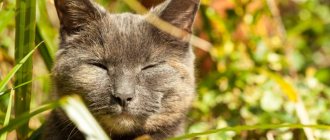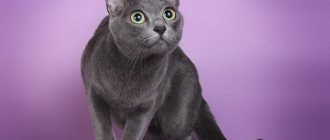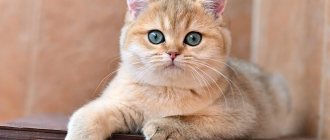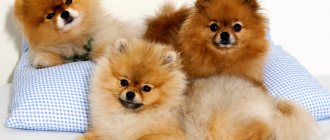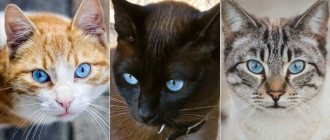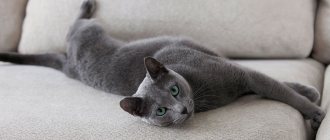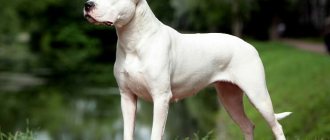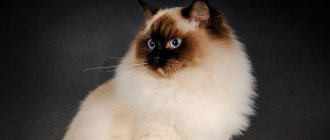The ginger fluffy cat is a classic representative of the cat family. In the natural environment, its pure (without impurities) color behaves capriciously. Red shades of fur appear in offspring only if a number of hereditary conditions are met, but even felinologists do not undertake to predict its appearance in advance.
This color is unusual for the British, but among the Persians, on the contrary, it is not considered a rarity. However, all cat breeds have one thing in common - almost every litter produces babies with a luxurious red coat.
Are there ginger cats that are girls?
Boy and girl cats have different sets of chromosomes:
- the cat has a double X chromosome (XX);
- The chromosome set of a cat is XY.
As for the O gene, it is attached only to the X chromosome, and has two “coloring” alleles: O (red) and o (black). In practice this is expressed like this:
- OO with two XX in girls gives a red color;
- the same chromosomes with the oo alleles create a black tint;
- With a set of Oo, two-colored (tortoiseshell) kittens are born.
Male cats have fewer options because they have only one X chromosome, which can be accompanied by a single allele expression: O (red) or O (black). But nature did not program cats with two-color red and black colors.
In practice, this complex genetic kaleidoscope is expressed in the fact that in a litter there are fewer red cats than males.
Important! Under natural conditions, ginger cats are born approximately 3-4 times more often than female cats. This even causes the unfair judgment that only boys wear bright sunny coats.
Information from genetics
The cat's genetic code consists of a pair of chromosomes that determine the sex of the animal. In boys these are two different XY chromosomes, and in girls they are XX. A gene linked to the X chromosome is responsible for the presence of red pigment in hairs, as well as black ones. It can be assumed that cats have a much greater chance of getting two red genes at once, because she has the XX set of chromosomes. But nature does not look for easy solutions.
It is very rare that two chromosomes are equipped with the red gene at once. Most often, one X chromosome carries the orange gene, and the second has the dark gene. It turns out that multi-colored cats are born with a two- or three-color coat. In the male sex, the X chromosome, to which the orange gene is attached, is dominant, so cats are born with a predominance of red hair.
Will dreams of a red cat remain unfulfilled? It is very difficult to predict which gene will be dominant in a pet. The appearance of a ginger cat in a litter is quite rare, but still possible.
According to statistics, cats with a red color are four times less common than male cats.
More common is the appearance of multi-colored cats, in which red stripes and spots are combined with black and white.
If a male or female kitten inherited from its parents, in addition to the Orange gene, also a diluent gene in a homozygous state, then the shade of the coat will not be bright red, but pale, that is, cream.
Color options
Since a cat has more color options, it means that she also passes them on by inheritance:
- Only the red allele O is passed from mother to male cat;
- Characteristics of two parents are passed on to female kittens (genes O and O).
Other colors and color spots that were present in the animal’s relatives play a role in the formation of coat shades.
- White-red cat. The white gene (W) is dominant over all others, the spotting (S), partial spotting (Sp) allele and the white recessive ww allele also work. The tendency to white spotting is always dominant in relation to solid colors.
- Red tabby cat. The fiery color is never continuous. It definitely shows patterns in the form of stripes or marble spots. In genetics, this effect is called “tabby” and it is responsible for the characteristic pattern on the coat.
- Red marbled cat. We are talking about shading the tabby pattern. In ginger cats it is necessarily present, but in varying degrees of contrast. A heavily shaded tabby looks like a pure color, a slight blurriness leads to a distinct pattern, a moderate shade is associated with marble stains.
- Cat in light red tones. The D gene comes into play. It is responsible for color saturation and colors the hairs a deep and uniform red. But in the dd modification, lightening occurs, then the pigmentation granules in the hair structure are sparse.
- Cat in black, white and red tricolor. The combination occurs only in girls. Cats are deprived of this color due to a single X chromosome, to which only one allele responsible for pigmentation can be attached. The exception is male individuals carrying the chromosomal formula XXY. But they are, as a rule, sterile and do not take part in reproduction. Therefore, the white-red and black color is the privilege of cats.
- Black cat with red spots. A kitten gets tortoiseshell coloring from two parents who carry the genes for black and red hair pigmentation. Most often, girls become carriers of this combination.
Important! A total of nine colors form the main color palette of cats. An ordinary ginger cat must receive the red pigmentation gene from two parents. Otherwise, he will not have a sunny coat color.
Genetic aspects
The sex of an animal is determined by the set of chromosomes: XX for a girl, XY for a boy. And the red color of the coat (scientifically - red) is caused by the pigment pheomelanin, but its manifestation depends on the state of the Orange gene responsible for the color - dominant (O) or recessive (o). It is attached specifically to chromosome X, so, at first glance, females have a much greater chance of getting two orange genes at once. But in reality, everything happens exactly the opposite. The fact is that very rarely the red gene is present on two chromosomes at once: usually one of them carries the gene for a dark color. So most often we get multi-colored cats with a two- or three-color coat. But for the male sex, the X chromosome is dominant; therefore, cats with a red tint of fur are born much more often.
Thus, there are also girls among red cats, but they are much less common. In addition, it is impossible to say in advance what the genetic code of an individual will be and whether the Orange gene will be dominant. But depending on the color of the parents’ coat, it is possible to calculate with a high degree of probability what color the offspring will be:
- red females and males will have offspring of the same color;
- a red or cream female and a dark (brown, lilac, blue) partner will have boys like their mother, girls will have a tortoiseshell color;
- a dark female and a red male will have boys like their mother, girls will be multi-colored.
- a female tortoiseshell and a black partner may have girls as their mother or father, boys may be black or red;
- in a female tortoiseshell and a ginger cat, girls can be any of these colors, boys can be black or red.
Red female cats are found approximately 4 times less frequently than female cats. Among the first, there are often multi-colored ones, when several colors are mixed in different combinations in one animal.
Breeds of red cats
A cat with a red color can be found among both purebred and mongrel pets. "Ryzhik" can also be fluffy or short-haired.
British cat
A short-haired cat with a strong, muscular body and thick, silky fur. The most popular color is smoky blue, solid or tabby. Red shorthair cats of the British breed are rare and there are much fewer girls among them than boys.
But among the British, sometimes there are long-haired cats; they look especially interesting in their white and red color. Breeders sought to obtain new shades, and as a result of crossing a British cat with Somali and Persian breeds, luxurious, lush fur was fixed in the genotype.
Siberian cat
Representatives of this breed have long, lush hair (with hypoallergenic properties) and a double undercoat. Siberian fluffy ginger cats with eyes of a rich orange-amber hue are a great rarity; many catteries are separately engaged only in their selection.
Even more unique are Siberian ginger cats with a tabby striped pattern and white accents on the shirtfront and paws. There are no such animals in the group of smooth-haired pets.
Maine Coon (Manx coon cat)
A very large cat, its height is 1 meter in length and its weight exceeds 8 kg. Unlike other breeds, which reach their maximum size by the age of 2, Maine Coons grow until they are 3-5 years old.
Red female cats are no more common among Maine Coons than among their Siberian relatives. They look very impressive thanks to their large ears with predatory tassels and their stern, attentive gaze. There are white and red kittens and striped red tabbies.
Persian cat
A breed that has become a separate cat brand due to its remarkable appearance and ancient pedigree. The coat color of a Persian cat can be any color - there are about 100 shades, with red (red) being no exception.
The colors of red Persians are considered in a wide range - from light to rich red.
Turkish Van (white cat with red spots)
Semi-longhaired cat, strong, graceful, with high muscular legs. The body is covered with white hair (at least 80% of the surface), the entire tail is red (red, chestnut) in shades with the obligatory ring inserts all around and the same spots at the base of the ears.
Turkish Van girls can be carriers of tricolor color variants.
American Curl
Fiery colors are not common among the American Curl, but white cats with red spots are sometimes found. Seals can also be born with colors like the Turkish Van - a white body, a tail painted in shades of red and spots around the ears.
Breed characteristics
Red coloring in pets is very popular, but it is not a breed-defining trait. Nevertheless, breeders have learned to artificially produce certain color options using certain calculations. Although outbred animals can also have red fur, for some breeds it is a completely natural color. Among them:
- Persian;
- Siberian;
- British;
- Maine Coons;
- Somalia;
- Karelian bobtails.
If a kitten receives from one of the parents not only the Orange gene, but also the so-called diluent gene, the coat color will be delicate, muted (peach), and not bright red. This color is especially characteristic of British and Persian breeds.
It is also believed that you can increase the intensity of color using:
- Adding iodine (seaweed), beta-carotene (found in carrots) to your pet’s diet in the form of natural products or nutritional supplements. Copper deficiency can contribute to “bleaching” of the coat.
- The use of special care products, which is more important for pets participating in exhibition activities.
Signs associated with ginger cats
Red cats, just like black ones, are haunted by all sorts of legends.
- It is believed that red pets are always obstinate and overly independent. In fact, there is often a very strong emotional connection between an animal and its owner.
- Picking up a ginger kitten on the street and bringing it into the house means attracting prosperity and good luck. Since the fiery color is no more common among street vagabonds than among their purebred relatives, not everyone will experience such happiness.
- Some people believe that a sunny-colored cat absorbs negative energy and protects a person from negative influences.
They also say that they purr louder than others, cure alcoholism, and predict illness and death. The only true observation is expressed in the popular saying “a cat in the house means happiness in it.”
Napoleon
This breed got its name due to the small height and weight of the animal. Everyone knows that Napoleon was short. The color of this breed can be very diverse: red, peach, white, gray. There are two varieties of the breed: classic, with long legs, and extreme, with short legs.
Representatives of this breed are very peaceful and get along well with other pets. They require increased attention and often suffer from loneliness.
Note: Napoleons are very patient with small children and may well become their friend.
Care
During molting, cats with luxurious fur coats need to be brushed every day, and this lasts for almost two weeks. A great option would be to use a powder brush. The rest of the time, you need to scratch the handsome man twice a week, and for this you will need a wooden or metal comb. On other days, the cat will handle the fur just fine.
The need for walking is the same as for dogs. Representatives of the Siberian cat breed (whether they are red, black or white) love to walk, and this desire does not disappear with the onset of cold weather. If you live in the private sector, then ensure safe walks so that the animal does not end up under a car, in the teeth of dogs or in the hands of unscrupulous people. While living in an apartment, you can take your pet for a walk by purchasing a beautiful harness.
As for bathing, it will be required only in case of severe contamination, when the animal cannot cope on its own. There will be no difficulties when swimming, since the Siberian breed is not afraid and even loves water. There is a rule here: never wash your animal with your own or your dog's shampoo. You will need to buy a specialized one for cats with long and thick hair.
Don't forget to clean your ears. Teeth also need care, this will prevent the formation of stone.
You won't have to trim your claws if you provide your animal with a good, comfortable scratching post. In addition to the usual rag scratching post, you can put a wooden board, the huge Siberian cat will happily spend time with this device.
We must not forget about the need for personal space. A cat sometimes needs to hide, retire, and relax, and for this it is better to put up a cat house; it is much more comfortable in it than under the bed.
If living and feeding conditions are good, the animal will live a long life - up to 20 years!
Ural rex
This is an aboriginal breed of cat, spotted in the Urals in the pre-war years. Its distinctive feature is its curly coat, which naturally forms into graceful curls. Curly-haired cats are few in number and not as popular as Persians or Maine Coons.
Ural rexes are smart, affectionate and silent, they love to spend time with children and adults, and sleep with their owners. They remain loyal to their owner, while calmly treating strangers.
Pets of this breed are distinguished by good health and do not require special care. Ural rexes are unpretentious eaters and can feed on foods of natural origin.
Don Sphynx and St. Petersburg Sphynx (Peterbald)
The calling card of both breeds is the absence of hair. The standards of both allow any colors. Both Donchaks and Peterbalds come from the same cat, born in Rostov-on-Don in the late 80s. They equally love heat and hearty food. How are they different from each other?
Build and character. Donchaks are strong, muscular cats, with a wedge-shaped head with wide cheekbones and large ears set high and wide. They have a friendly, sociable character. Peterbalds are much more graceful - a slender body on thin high legs, a long tail, an elongated head and huge ears. Being descendants of Orientals and Siamese, Peterbalds are very active, talkative and affectionate.
British (shorthair and longhair)
A nice, strong body, a cheeky muzzle and thick plush fur are for some reason associated with blue or chinchilla colors. In fact, the standard allows for almost all colors, and the red Briton is an impressive sight!
At one time, Persians were used for breeding by the British, so the birth of long-haired kittens was common. The “heavy Persian heritage” has long been considered a breed defect. Only recently have enthusiasts managed to achieve recognition of a new breed - the British Longhair.
